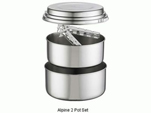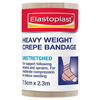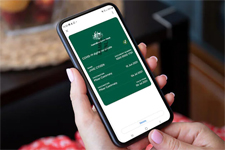![]()
What to Bring
Katoomba to Kanangra 4 Day Hike
by Ashley Burke
What to Bring Katoomba to Kanangra 4 Day Hike by Ashley Burke |
This equipment list is suitable for MountainSphere's Katoomba to Kanangra 4 day hike. For more information about this guided 4 day hike please see the Katoomba to Kanangra page.
Equipment List - Katoomba to Kanangra (K2K)
The Katoomba to Kanangra 4 Day Hike covers some of the highest peaks in the Blue Mountains and for some of the route it follows the Gangerang Range which in poor weather is exposed to the elements, windy, cold and wet. The route passes over the summit of Mt Cloudmaker that is called this for good reason. Two of the camps, at Splendour Rock and Dex Creek are both high and in the winter months can be cold. The Coxs River campsite can also be cold and damp. Please take note of the season and current weather conditions when deciding the amount of warm or protective clothing to carry on this walk.
| Item | Comments | Availability |
| Sleeping bag | The sleeping bag should be 3-4 season rated, or temperature rated to zero degrees celsius. | |
| Pack/Rucksack | Minimum volume 60L. Try to pack everything inside. Avoid loose items strapped to outside of pack. Foam mats can get scratched or torn if strapped on outside of pack. | Can be borrowed for a small fee. |
| Lightweight tent or space arranged in shared tent. | Your tent should be a small lightweight 3-4 season tent. There are many brands available. It may be possible to share tents. I can help organise tent accommodation. Contact me about borrowing or sharing a tent if you do not have one. If you do have a tent with spare space, please let me know. Rent a Big Agnes 1-person tent: $50 for 3 nights |
You may borrow a lightweight 1-person tent for 3 nights for $50. Brands: Big Agnes or Nemo 1-person tent Weight: Between 1.0 and 1.3kg |
| Sleeping pad, eg: foam mat or thermarest | A foam mat can be purchased inexpensively from camping stores. Other options are Thermarest or similar brands such as Sea to Summit or Nemo sleeping pads. There are many different models in the Thermarest range. The Thermarest NeoAir is the lightest for the amount of warmth, insulation, comfort and compactness. |
Borrow a Thermarest Prolite for 3 nights for $20. |
| Waterproof and windproof shell jacket | Can be lightweight. | |
| Water bottle(s) | Enough to hold 3-4 litres is required. Important as at Splendour Rock we will not be camping by water. 4 x 1L Nalgene bottles are recommended. Alternatively just take old soft drink bottles. |
   |
| Water | Start the walk with 2 litres of water. We will refill before camp on the first day. | |
| Torch | A small head torch is ideal | |
| Fleece or warm jumper | Depending on season | |
| Thermal underwear | Top and bottom | |
| Hat, sunglasses, suncream | ||
| Walking shoes | For further advice on walking shoes, contact me directly | |
Cooking and eating utensils:
|
Camping stoves are optional. We may have a campfire which you can use for cooking on although most people cook on a lightweight gas stove. Camping stoves can be shared, and I can provide you with boiling water for your cooking needs. A "billy" is a small aluminium pot which is used to cook over the fire. Alternative to a billy if using a stove is any kind of camp cookset. |
  |
| Camping stove (Optional, can be shared) | We adopt a minimal impact approach to bushwalking so stoves are preferred over campfires and we will always adhere to park fire bans or total fire bans. Stoves may be shared, one between two. If you do not have, or don't bring a stove, you may either share mine or have me boil water for you, There are many types of camping stove. For this type of trip, a gas stove such as Soto Windmaster, MSR pocket rocket or similar is light, compact, and easy to use. |
|
| Food | Bring enough food for yourself for the duration of the trip. Normally everyone brings their own food unless specific arrangements to share food are made. See food suggestions below for help on what sort of food to bring. For the Katoomba to Kanangra 4 day hike you require: 4 lunches 3 dinners 3 breakfasts Add 1 to each of the above if doing the hike over 4 days. |
|
Hiking attire:
|
Shorts or long pants? This depends on personal preference, and time of year or expected temperatures. Bear in mind that you will be walking through scrub which may be dense in places and therefore long pants are recommended. In the summer months or in hot weather, shorts are ok, though gaiters are highly recommended if hiking in shorts. | |
Additional warm clothes (depending on time of year):
|
Check the weather forecast prior to the trip. The weather in May-September can be variable and cold weather is likely, especially at night. Ensure you have sufficient warm clothes for chilly evenings and mornings. Most likely not needed on trips in March, April and October. | |
Personal items:
|
Keep to minimum. Due to limited water availability and for environmental concerns, do not bring soap, shampoo or detergent. Hand sanitizer gel (that doesn't require water) should be used for hygiene and for cleaning hands after toileting and before handling food. First aid kit must include as a minimum:
Also recommended:
|



|
| Compass (Optional) | The Katoomba to Kanangra walk is an opportunity for you to practise navigation skills learned on the MountainSphere navigation training weekend. Bring your compass with you, and enough maps will be provided for the group to share on the weekend. I can supply compasses at competitive prices. Compasses can also be purchased from camping and outdoor stores or online. On this trip a compass is optional. For information on what is the best compass to buy, see Section 7.2 of my navigation tutorial. |
 |
Topographic Map of the area we will be walking in. Optional Katoomba 1:25000 (8930-1S) Jamison 1:25000 (8930-2N) Jenolan 1:25000 (8930-3N) Kanangra 1:25000 (8930-3S) |
The entire K2K route spans 4 maps in the NSW 1:25000 topographic series. Two of these maps (Katoomba and Jamison) are used on Day 1 only and only the Jenolan and Kanangra maps are needed for most of the hike and all sections where navigation is required. Enough copies of the Jenolan and Kanangra maps will be provided on the trip for one copy of each map between two people. That way you only need to carry one map each, and everyone can share maps one between two to participate in navigation. Please contact me directly if you would like your own copy of both the Jenolan and Kanangra maps. |
|
| Money | For your personal expenses travelling to and from the start point, and any accommodation or meals in Katoomba. Payment for the trip is required in advance, however you may purchase maps, compasses and other gear on the day for cash. |
|
| Whistle | A whistle is an important safety item for attracting attention in an emergency or in the unlikely event that you become separated from the group. Some backpacks come with a whistle built in or attached. These are often too small and feeble for a genuine emergency. Bring a separate pealess whistle if you have one. If you don't have one, MountainSphere can supply one for you for the trip. |
Recommended brand: Fox 40 Sharx Pealess Whistle |
Proof of COVID vaccination (Mandatory until at least 1 Dec 2021) |
It is mandatory until at least 1st December 2021 that all clients and staff attending any MountainSphere trip be fully vaccinated with at least 2 doses of a TGA approved COVID vaccine. You will need to provide proof of vaccination before attending the trip. Your vaccination should be considered part of your safety gear, brought with you along with your first aid kit, protective clothing, and everything else that you carry to keep yourself and others safe. The NSW Government health orders and rules concerning COVID vaccination will be adhered to, and if those rules mandate vaccination then those rules will apply to everyone attending this trip. Where government health orders do not mandate vaccination, MountainSphere Adventures nevertheless strongly encourages everyone attending to be fully vaccinated. For more information about COVID and how to provide proof of vaccination, please refer to the NSW Government website. |
 |
Keen to join the Katoomba to Kanangra walk? Click below:
It is normal practise for everyone to bring their own food for the trip. That way, each person can eat according to their own preferences and diet, and less time is spent organising communal food.
Below are some suggestions on the sorts of food that are suitable to bring on the Katoomba to Kanangra hike. These are suggestions only, based on what I normally take on this trip. Everyone's tastes and diet are different, so feel free to make any changes to the list below based on your preferences. Also feel free to contact me if you have any other questions about what sorts of food to bring.
On the Katoomba to Kanangra 4 day walk you will need:
General Comments
Things to avoid:
On the other hand, food can be fun and easy to cook when camping, and it is possible to have good variety, including fresh foods for at least the first couple of days.
Freeze dried meals are a popular choice and are easy to prepare, though more expensive and lacking in fresh ingredients. If you bring a freeze dried meal, I can provide you with boiling water to rehydrate your meal. This is a good choice for keeping your pack weight to a minimum.
Breakfast
and/or
or
and
Lunch
and
Dinner
and
and/or
Extras
If you like to snack between meals then you can bring anything such as chocolate, nuts, biscuits, snack bars or other snack food.
All content on this web page is Copyright © Ashley Burke. No duplication of any text or image without permission. Web page last updated 06 Oct 2021
|